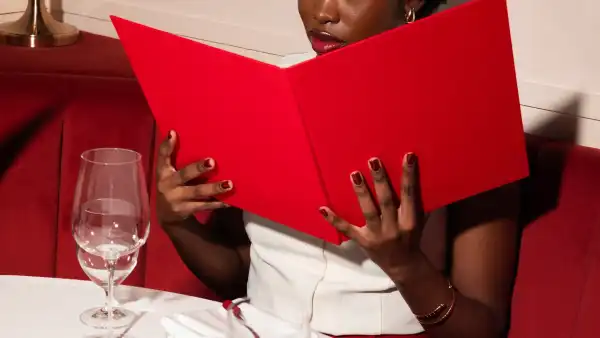
Save this storySave this storySave this storySave this story
Remember the Trompe l’Oeil Sweatpants from Balenciaga? The nearly twelve-hundred-dollar heather-gray drawstring pants that seemed ordinary, innocent of fashion, until the shopper, scanning upward, caught the plaid trick happening at the waist—the idea. It was the suggestion of male underwear, red plaid fabric stitched onto the top of the sweats to mimic the appearance of exposed boxers, a look called sagging. The idea—a missive from the world of Demna Gvasalia, the creative director of the brand, who is hailed or scorned as the priest of postmodern dressing—forced a moment of critical reflection. As it is with clothes and the vague emotions aroused in us when we think about them, let alone wear them, these days, much of the reflection happened on TikTok. A user, seeing the pants on a rack at Selfridges, thought aloud, “This feels racist. This feels very racist, guys.”
Academics were called into the discourse, shading in elegant historicizing to the charge, which was an obvious one about commercialism and the Black man, policed for his presentation, drained dry of his innovations, sartorially, to say nothing of the rest. These public conversations feel cold and clinical, as Black people are pinned down and wriggling under the microscope. But the froideur doesn’t preclude correctness. Once European fashion houses stopped pretending that they were ignorant of Black culture, they began to openly feed on it. Sagging had made young Black men objects of scorn, particularly by the paternalists—Bill Cosby, the father; Barack Obama, the politician; and Eric Adams, the cop—who had each done their separate campaigns admonishing the brothers for not pulling up their pants. The derision was predicated on protection. Black man, make them respect you by your dress. Black man, hold yourself high. Legislation against sagging—modern morality ordinances, passed in municipalities in states such as New Jersey, Illinois, and Michigan, and across the South—became a possible pretense for arrests. In February, 2019, in Shreveport, Louisiana, Anthony Childs died while being chased by police, who pursued him for a “saggy pants” violation. They engaged in gunfire, and although the coroner ruled Childs’s death the result of a self-inflicted wound, he was killed in a confrontation that never should have happened in the first place. Did Balenciaga care? The brand’s sweatpants, looked at through the prism of death and disrespect, were a real problem and a sort of social evil, conjuring bodies in effigy. Like David Hammons’s severed hoodie, nailed on the high plane of a white wall, the shape of the lost head still there, but with no soul to give us commentary.
There is no way Demna and company didn’t know what they were doing with their controversial waists, no way they weren’t curious about the power of showing your ass, so to speak. Punditry, lay and serious, does not really cope with the atmosphere in which a designer like Demna and his artistic peerage create, which isn’t blasé, and which certainly is not race-blind, so much as it is antic. There is a strong belief in dressing “wrong,” a belief that can be situated right at the area of the waist. Sagging used to unnerve the world because it made explicit, even erotic, the male body. It gives men what women supposedly have: curves. (A half-conscious homophobia inspired a lot of the vitriol toward low-slung pants, too). The look doesn’t outrage as much in this decade. For one, the waists rose and the circumferences shrunk, as Black men played with the proportions of the prepster and the dandy, in the years after. Also, the waists exposed are different. Isn’t it funny to go downtown and see the teens, obsessive thrifters, dressed in the voluminous shapes of rappers in the two-thousands, looking like anything but themselves? And of course, the wrongness—the jeans, dragging on the sidewalk, overlarge at the waist, freely exposing ass crack—has its own rules. One known inhabitant of the style is the singer Billie Eilish, very famous, very white. Eilish has always been drawn to the baggy and the obscuring. She likes the way the clothes make her feel, and she likes that the silhouettes make it hard to ascertain the lines of, and therefore sexualize, her body. Eilish’s style has grown more elaborate, as of late, gayer and Blacker, with the flourishes of bandannas and snapbacks, the frameless Cartier-style glasses of the sort you would expect to see sitting low on the nose bridge of a fashion head from Atlanta or Detroit. The accusations of cultural appropriation directed her way are not truly strident, though. They’re mostly bewildered. How does a twenty-two-year-old come to dress like Chingy?
The dissolution of strict gendered dressing is the stale chat of this millennium. But what’s explored less often is the disarticulated element of race play. I think of HommeGirls, a magazine and a clothing brand, launched by Thakoon Panichgul, in 2019. The name, omnivorous, manages to pun on Rei Kawakubo’s Comme des Garçons, which is already referencing Françoise Hardy, the French delineation of the genders, and the old slang for what you would call your good girlfriend. A popular item from HommeGirls is its chambray boxer, which the wearer knows she can pull up so that it shows over the band of her low-waist jeans. The aura of the gamine encircles HommeGirls. We’re not in the environment of queerness, of deep androgyny. The brand’s mission statement, citing Joan of Arc, Katharine Hepburn, Yohji Yamamoto, preserves still a sense of glamorous difference: “There is a boy in every girl, an homme in every woman.”
What the waist does in clothing, and what it can do to clothing, is the site of enduring and inchoate panic. For all the literacy around Instagram Face, there isn’t commensurate seriousness applied to our culture of body modification, associated with women marked by their race, their class, their transness. The B.B.L. body, created through surgery or through girdle training, is as if a tailoring of the flesh. The woman with the Coca-Cola-bottle shape means to look like she’s been carved—she is not at the mercy of Ozempic naturalism. Not many days after giving birth, Cardi B went to Paris Fashion Week with an extreme waist, thanks to her dutiful wearing of a magnified faja, or girdle. (The name of one of the more popular sculptwear brands riffs on the compliment given to a “snatched” person: What Waist.) Some who may have a more subdued relationship to body alteration feel they are controlled by trend, their buying practices decided by a divining rod. When millennial women got informed that the proper pant silhouette of the twenty-tens, the high waist—which truncated the torso, elongated the leg, and made of every ass a pear—was on the way out, with low-rise making its incursion again, there was a lot of real anger. They were aging, and their bodies were changing. They felt haunted by the tabloid era of Paris, Britney, and Lindsay—by their own fear of trash. Really, this resuscitated low-rise asks for something else. The trouser shape is in vogue; women are knowingly buying pants a size or two larger, deëmphasizing their trunks, creating billows with their legs. But so are men. I get a thrill spotting the dipped waists and gaping, pleated legs. Abercrombie & Fitch, J. Crew, American brands plotting comebacks, are pushing the drop waist, unimaginable just a few years ago. The temperance look feels like a reaction against a beauty standard drifting away from whiteness; in other words, it is related to the death of Kardashianism, where even the sisters appear to be lightening their tans and slimming their backsides.
The racialized waist was on my mind, earlier this month, when the Metropolitan Museum of Art announced the theme of the Costume Institute’s 2025 exhibition, the sometimes forgotten companion to the celebrity-filled gala. Next year’s celebration, informally dubbed the “Men Gala,” is called “Superfine: Tailoring Black Style,” and it will revolve around the figure of the Black dandy. This comes after the rumors about the last Gala, that a new theme was rushed in when the museum’s leaders rejected what was allegedly Anna Wintour’s original plan: a celebration of John Galliano, the designer who was fired from Christian Dior for his racist and antisemitic rants. However this next show came to be, the decision validates a long-manifest turnabout, which is that the muse of visionary dressing is now the man. The dandy, in his cinched and showy wear, is the ur-creature of Black fashion. He is a figure best understood from the vantages of the eighteenth, nineteenth, and twentieth centuries, although modern people and modern designers, such as Grace Wales Bonner, a remixer of suiting from Europe, West and East Africa, and the Caribbean, do his work. If he is a man, then he is not in fear of muddling the binary, with his heeled chaussures, coiffed hair, and conspicuous jewelry. And he may not even be a man. What New Negro outdid Gladys Bentley, the lesbian blues singer of the Harlem Renaissance, in her tilted top hat, cane, and tuxedo, all shockingly white?
What will it mean to have any and all “honor” the dandy, to dress in his formidable shadow? It should seem startling that the Gala night distinctly pleads for drag. Problems will strut down the steps, and they will be interesting ones. The guest curator of the exhibition, Monica L. Miller, is the author of “Slaves to Fashion: Black Dandyism and the Styling of Black Diasporic Identity,” published in 2009. Miller brilliantly traces a “transformation in black style—from costumed object designed to trumpet the wealth, status, and power of white masters to self-styling subjects who use immaculate clothing, arch wit, and pointed gesture to announce their often controversial presence.” A tragedy that André Leon Talley didn’t live to put the coming mise en scène in its true proportion. ♦
Sourse: newyorker.com






